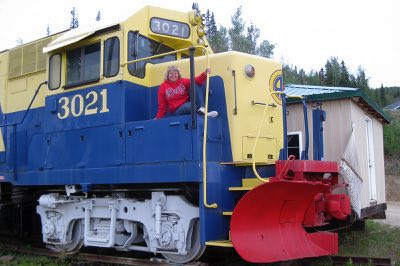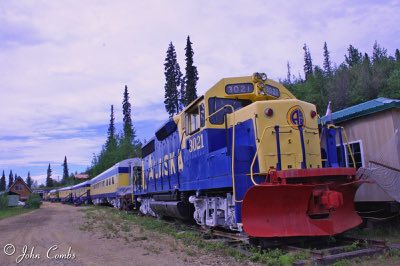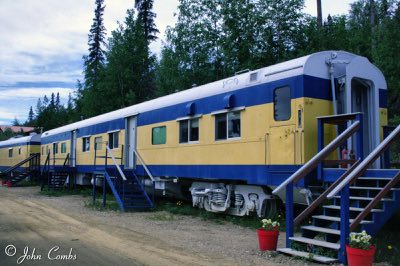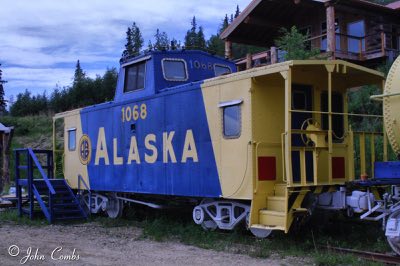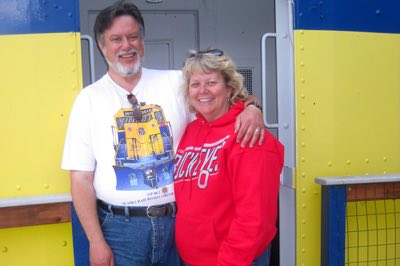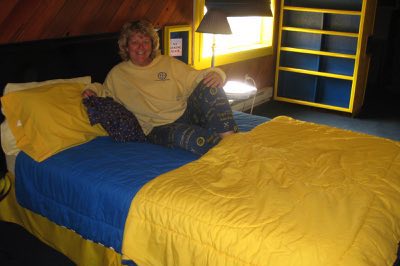Monday June 16, 2014
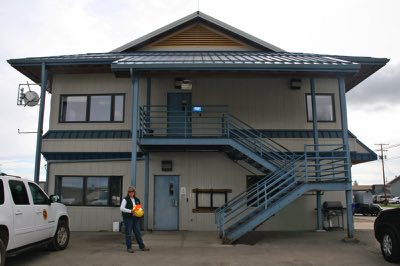 I began my website in April 1997 with the intent of locating Alaska Railroad HO scale models for my basement train layout. What happened over the next few years defied explanation. Hundreds of railfans, historians, modelers and employees came out of the woodwork and began contributing information to the website. Before long I had numerous individuals contacting me with questions and requests for information. My "hands on" knowledge was virtually nonexistent so I would contact my sources and extract from them the required knowledge which I would then pass on to the requestor. I was nothing more than a conduit. All that changed in June 2000 when I made my first real railfan trip. I began becoming less of a parrot and more of the horse's mouth. With each subsequent trip I gained more and more first hand knowledge. As the popularity of my website grew the railroad not only acknowledged my existence, but also assisted in broadening my horizons.
I began my website in April 1997 with the intent of locating Alaska Railroad HO scale models for my basement train layout. What happened over the next few years defied explanation. Hundreds of railfans, historians, modelers and employees came out of the woodwork and began contributing information to the website. Before long I had numerous individuals contacting me with questions and requests for information. My "hands on" knowledge was virtually nonexistent so I would contact my sources and extract from them the required knowledge which I would then pass on to the requestor. I was nothing more than a conduit. All that changed in June 2000 when I made my first real railfan trip. I began becoming less of a parrot and more of the horse's mouth. With each subsequent trip I gained more and more first hand knowledge. As the popularity of my website grew the railroad not only acknowledged my existence, but also assisted in broadening my horizons.
Today the Alaska Railroad had been kind enough to facilitate a tour of the Fairbanks yard and surrounding companies supported by the railroad. An experience such as this helps to bolster my knowledge base as well as understand the railroad's valuable role it plays in the community. As Terry and I got out of the car I had a warm heightened sense of awareness. I could feel the scuffing of gravel under my boots, smell the rich aroma of diesel fumes in the air and hear the sharp clanking of couplers in the distance. You could almost feel the pulse of the railroad.
We met our tour guide at 11:30AM sharp in the yard office. After a short greeting he checked over our Personal Protective Equipment to ensure it was adequate. A hearty thumbs up told us we were good to go. One of the things I like about the Alaska Railroad is I can easily get my hands around it. Unlike the Union Pacific or BNSF which has a mind boggling number of locomotives, freight cars, support buildings and employees the Alaska Railroad is smaller and simpler giving it a more friendly homey kind of feel. We strolled around the small shops and learned one of the GP40s was down for repairs. Our guide added it was a rare occurrence that all three black and yellow Geeps (numbers 3001, 3003 and 3006) were currently in Fairbanks and we eventually spotted each one. As we rode around in his vehicle I must confess I felt like a kid in a candy store grabbing photo after photo in the northernmost rail yard in North America. I've included just a few of these photos below.
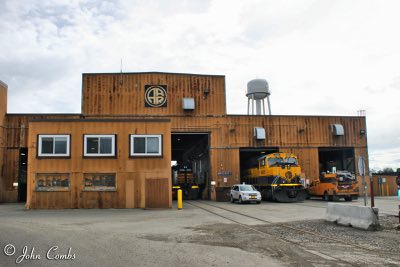 |
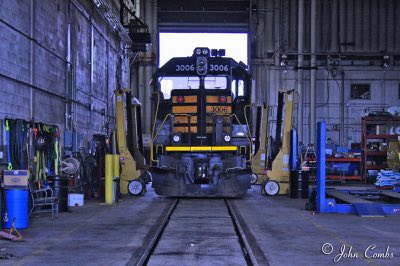 |
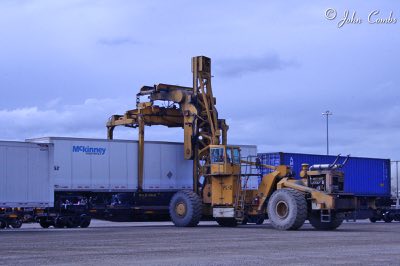 |
| The shop complex in Fairbanks. This building will also serve as a warming hut for diesel locomotives during frigid winter months. This improves air quality since engines can be turned off rather than idled in the railroad yard. | Here is GP40 #3006 in the shop for repairs. The Alaska Railroad's Fairbanks facilities include a rail yard, freight house, car shop, locomotive repair shop, and fueling station. | A piggy packer (vanlifter) loading a trailer onto a flat car. Trailers/Containers on Flat Cars (TOFC/COFC) move north and south between Seward, Whittier, Anchorage, and Fairbanks. |
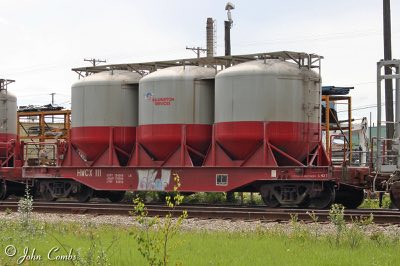 |
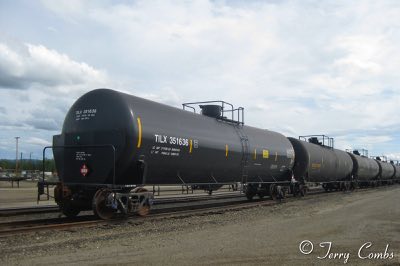 |
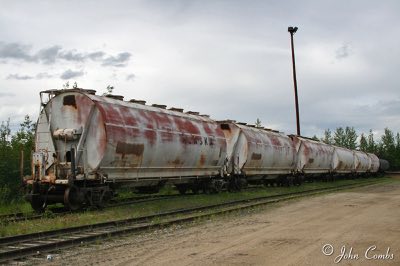 |
| One of three Halliburton Pneumatic Railcars in the yard | Tank car infinity | American Car and Foundry cylindrical cement hoppers |
After an hour or so of experiencing the fun of being a rail yard rat our tour guide drove us through all the various businesses that interacted with the railroad. We unexpectedly stumbled upon GP40 #3003 pulling a string of Container on Flat Cars (COFCs). Our guide was kind enough to drive us to various locations where we could safely grab a few photos of the switching operations.
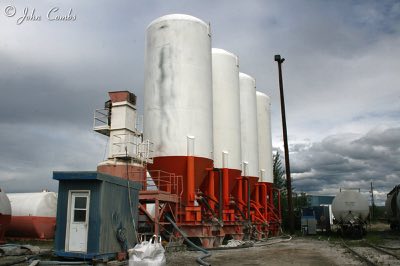 |
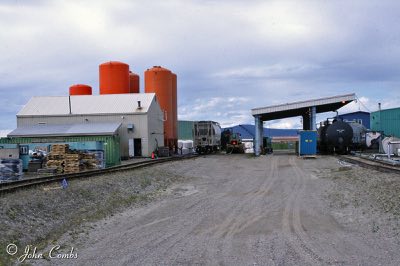 |
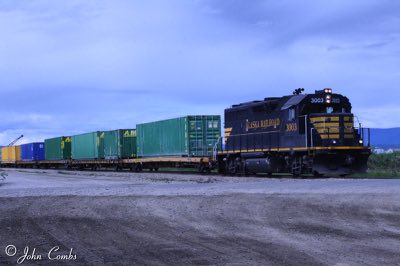 |
| Here are the cement silos at Alaska West Express. Most of their product goes to the Pogo gold mine in Delta Junction. "Pogo is notable for its paste backfill system, wherein a portion of the mine's tailings from which gold has been extracted are mixed with cement and then pumped back underground to support subsequent further excavation." - Wikipedia | Brenntag Chemicals capabilities include packaging, diluting, and blending liquid and dry chemicals to customer’s specifications such as hydrochloric acid. | GP40 #3003 pulling a load of intermodal COFCs. In 2015 Fairbanks trailer and container hauling business increased on-schedule delivery from about 50% to over 80%, thanks to collaborative problem-solving between ARRC and trailer/container-on-flatcar (TOFC/COFC) customers. |
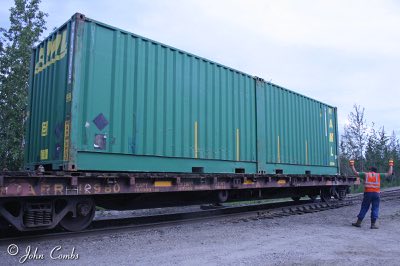 |
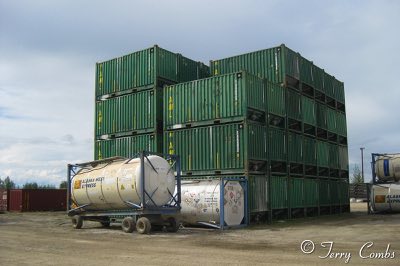 |
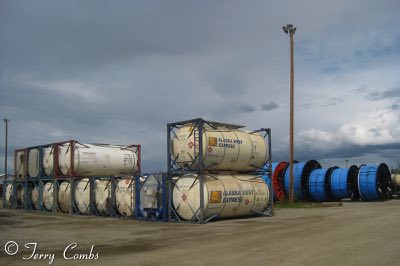 |
| Bringing the train to a stop | Alaska Marine Line (AML) 53-foot Jindo stackable containers and Alaska West Express bulktainers. | Alaska West Express bulktainers hold either liquids or gases and are transported via flat or spine cars. In October 2015 the ARRC became the first and only railroad in the nation to receive approval from the Federal Railroad Administration (FRA) to move Liquefied Natural Gas by rail. Hopefully, some day we will see new 40-foot portable super-insulated cryogenic tank containers riding the rails. |
After our tour guide dropped us off at our car we headed to the nearest McDonald's. My wife and I are not a big fan of their food, but typically stop for drinks with free refills, clean rest rooms, free ice for your coolers and free wi-fi. Refueled and refreshed we headed to Pioneer Park (formerly Alaska Land) a 44-acre city park in Fairbanks along the Chena River. There was no admission fee to enter the park, but many of the museums and attractions charged a fee. I had two "must do" stops: the Harding Car (Denali Observation car) and the Crooked Creek & Whiskey Island Railroad.
Locomotive #67 was blowing its whistle as we entered the park so I grabbed Terry's hand and headed for the depot to purchase tickets. The train ride took us completely around the park while an on-board guide dressed in period clothing pointed out all the historic attractions. Back at the station we peered through the glass at 1899 HK Porter 0-4-0T Number 1 which was the first locomotive engine in the interior of Alaska. The Friends of the Tanana Valley Railroad had lovingly restored it and placed it back into operation.
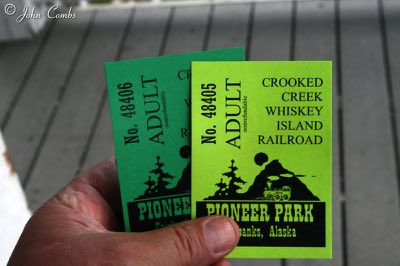 |
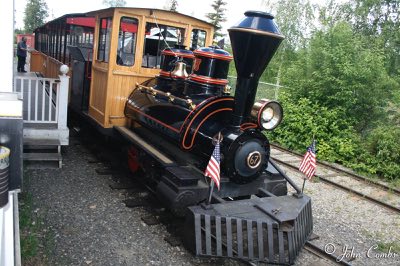 |
| Two tickets to paradise | Locomotive #67 ready to board passengers |
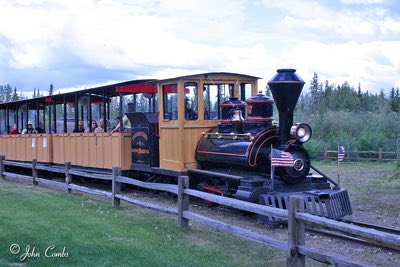 |
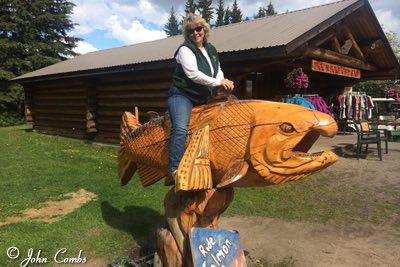 |
| Crooked Creek & Whiskey Island Railroad | Ride the salmon |
Our second stop was the Harding Car which was part of the "Congressional Special" train that carried President Harding and his party from Seward to Fairbanks and back in 1923. President Harding drove a golden spike at Nenana signaling the completion of the railroad on July 15, 1923. He then continued on to Fairbanks to tour the new Alaska Agricultural College and School of Mines.
The Harding Car had modifications made to it in 1928 and remained in service until 1945. It sat unused until the 1967 Alaska Centennial Exposition in Fairbanks where it was installed at Alaska Land and underwent yet another renovation. When I first saw the Harding Car in 2000 a large blue tarp was placed over the top to keep the rain water from pouring through the roof. The exterior paint was faded and a few of the wooden slats had broken off. Australian ARR railfan James Coy noticed things had not improved during his 2007 visit. Somewhere over the next nine years a wooden shelter was built over it, the exterior was repaired and repainted, and the interior cleanup and interpretive signs installed. What a great surprise! As if that wasn't good enough there was a geocache hidden there which Terry found almost immediately. Bonus!
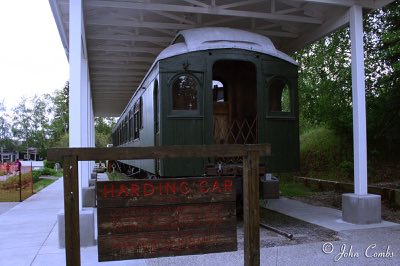 |
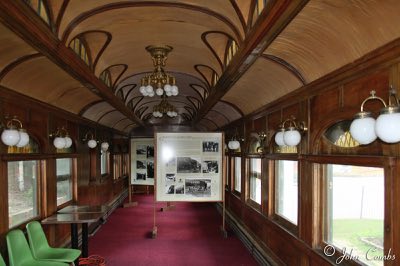 |
| Harding Car | Harding Car interior |
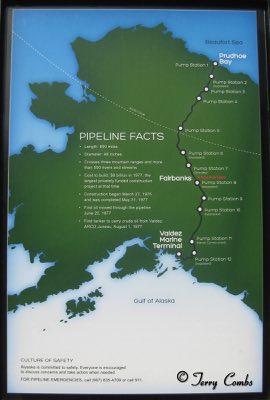
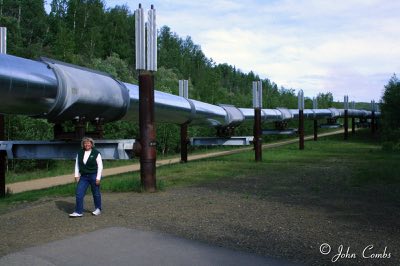 When I started my website one of the very first people with whom I connected was Fairbanks resident Tony Roof. He was selling his HO scale McKinley Explorer set and it became the first addition to my Alaska Railroad themed layout. I stayed in touch with Tony over the years and he sent me railroad photos and other information to add to my mecca. He also put me in touch with Conductor Duane Frank who became my first Alaska Railroad employee contact.
When I started my website one of the very first people with whom I connected was Fairbanks resident Tony Roof. He was selling his HO scale McKinley Explorer set and it became the first addition to my Alaska Railroad themed layout. I stayed in touch with Tony over the years and he sent me railroad photos and other information to add to my mecca. He also put me in touch with Conductor Duane Frank who became my first Alaska Railroad employee contact.
Several years ago Tony began geocaching and we connected on yet another level. I had hoped to link up with him on this trip and do some geocaching. Unfortunately his schedule did not allow us to meet while we were in Fairbanks, but we did manage to grab one of his geocache hides which I learned later delighted him greatly.
No Fairbanks trip is complete without a stop at the great Trans-Alaska Pipeline viewpoint. Jed Clampett discovered oil (just kidding) at Prudhoe Bay in 1968, but it wasn't until the 1973 oil crisis that made it economically feasible to build this behemoth oil conveyor. The project began in 1974 and had to deal with various obstacles such as permafrost, isolated territory, caribou migration, extreme cold, earthquake potential, Native objections and environmentalists. The construction boom attracted tens of thousands of workers and the Alaska Railroad hauled lots of building materials including setting up a "floating railroad" in Valdez. The first barrel flowed the 800-mile path from Prudhoe Bay to Valdez in 1977 and over 16 billion barrels followed suit. Alaska moved from the most heavily taxed state to the most tax-free state and in 1980 residents began receiving annual Permanent Fund checks. Terry and I enjoyed our visit with the added benefit of "finding" a virtual geocache.
We made a quick stop at the Alaska Railroad train depot in Fairbanks. Terry and I had both been inside before and even gotten a private tour of the huge HO scale layout. This time we just wanted a quick exterior photo, snag a geocache near the depot sign and check out the Maintenance of Way (MOW) speeder dedicated to Steve Love and his 50 years of loyal service to the railroad. Steve joined the railroad in 1958 (before Alaska was even a state!) as a member of a track maintenance gang. After 20 years as a track laborer and foreman, Steve was promoted in 1978 to his final position as Roadmaster. Every train service employee I ever met said Steve had the best maintained section on the railroad. When he retired he received a special service pin plus a "BEGIN LOVE SDG BLOCK" sign. This siding block sign is now posted along a siding that was renamed in Steve's honor. We then made a quick stop for Subway sandwiches and headed out for evening's lodgings.
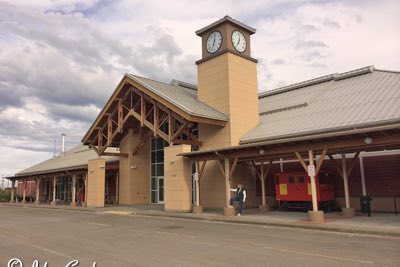 |
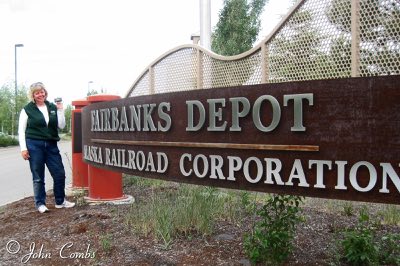 |
 |
| Fairbanks depot | Mrs. Amazing found the geocache | Steve Love speeder |
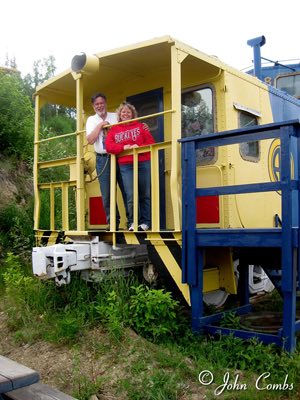 "I had a dream that I had a train up on our property," Sue Wilson said. "So the next morning, I called the railroad and asked if they ever sell any of their train cars. They said they put them up for sale from time to time, but they didn't have anything really. But they told me about a lawyer who had a caboose that he had bought and never moved off their property. He sold it to me." Then she broke the news to her husband. "Mike," she said, "I need to bring a caboose up to the house." - Anchorage Daily News 1/19/94
"I had a dream that I had a train up on our property," Sue Wilson said. "So the next morning, I called the railroad and asked if they ever sell any of their train cars. They said they put them up for sale from time to time, but they didn't have anything really. But they told me about a lawyer who had a caboose that he had bought and never moved off their property. He sold it to me." Then she broke the news to her husband. "Mike," she said, "I need to bring a caboose up to the house." - Anchorage Daily News 1/19/94
And that is how Mike and Sue Wilson started their Forget-Me-Knot Lodge and Aurora Express.
I had visited their unique business on two other occasions and even spent the night with them once. This time I wanted to bring Terry here so she could see and experience this fun quirky spot for herself. Not long after our arrival Sue appeared and took us on an all encompassing tour. Locomotive #3021 is the first thing a lodger sees when pulling into the lot and those not expecting it generally do a double-take. Mike and Sue bought the shell from the railroad for a very appropriate $3,021. They also have a tank car plus four passenger cars and a caboose which Mike converted into some strikingly unique bedrooms. The four passenger cars were part of the Denali Park Hotel since 1972 to add housing for tourists (Terry and I actually stayed in one on our first trip to Alaska in 1986). In 1986, it was determined the cars didn't meet housing codes and they were eventually sold to the Wilson's for $1.00 each. Two of them are 1924-era Pullman Standard cars which the Alaska Railroad eventually renamed Mount Susitna and Mount Iliamna. After acquiring the caboose, the Wilson's named it "Golden Nellie," in honor and memory of Susan's grandmother, Nellie LeVision, and features gilded golden ceiling, heavy emerald velvet curtains, queen size bed and a private bath.
Sue showed us several additions made since my last visit. Mike, a man with a true "can do" spirit, had built a shelter with tables, a peaceful stone waterfall area plus rounded up a narrow gauge locomotive and passenger car. He still plans on reworking the interior of the locomotive to accommodate overnight guests.
Due to its liberal use of blue and yellow colors Terry had chosen the passenger car "Arlene" in which to spend the night. I was also grateful for the "black out" curtains as there was still plenty of day light at 11:00 PM.
